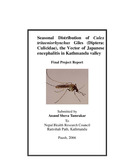Please use this identifier to cite or link to this item:
https://hdl.handle.net/20.500.14356/803Full metadata record
| DC Field | Value | Language |
|---|---|---|
| dc.contributor.author | Nepal Health Research Council (NHRC) | |
| dc.contributor.author | Tamrakar, Anand Shova | |
| dc.date.accessioned | 2012-12-28T23:30:27Z | |
| dc.date.accessioned | 2022-11-08T10:21:01Z | - |
| dc.date.available | 2012-12-28T23:30:27Z | |
| dc.date.available | 2022-11-08T10:21:01Z | - |
| dc.date.issued | 2009 | |
| dc.identifier.uri | http://103.69.126.140:8080/handle/20.500.14356/803 | - |
| dc.description.abstract | Summary: Japanese encephalitis (JE) is a common mosquito-borne viral encephalitis found in Asia, and is widespread throughout Asia. It is principally a disease of rural agricultural areas and primarily a zoonotic disease infecting mainly vertebrate animals, e.g. pigs, birds, horses etc. Pigs, wading birds and ducks have been incriminated as important vertebrate amplifying hosts for JE virus due to viremia in them. Man is involved in transmission cycle as an accidental host and plays no role in perpetuating the virus. The disease was first recordedin Nepal in 1978 as an epidemic in Rupandehi district of the Western Development Region (WDR) and Morang of the Eastern region (EDR). At present the disease is endemic in 24 districts. JE was confirmed in 40 residents of the Kathmandu valley, including30 cases that had no history of travel outside the valley duringthe incubation period. However, there is little information on the occurrence of this disease in the densely populated Kathmandu valley. The species Culex tritaeniorhynchusis suspected to be the principal vector of JE in Nepal as the species is abundantly found in the rice-field ecosystem of the endemic areas during the transmission season and JE virus isolates have been obtained from a pool of Culex tritaeniorhynchusfemales. No study so far has been carried out regarding seasonal distribution of Culex tritaeniorhynchusin Kathmandu valley. Entomological studies were conducted in Kathmandu, Lalitpur and Bhaktapur district of Kathmandu valley, in order to determine the abundance and seasonal distribution of Culex tritaeniorhynchus.Emphasis was given to select the villages located on the river side, pond, agro-field ecosystem areas and presence of cattleon the areas. During the study period altogether 4 man hours were spent searching mosquitoesin 16 houses by two collectors in Balkot (Bhaktapur district), Gothatar and Nepaltar (Kathmandu district) and Godavari (Lalitpur district) of Kathmandu valley in indoor and outdoor hand collection to collect adult mosquitoes resting inside the houses. Adult mosquitoes were captured using mouth aspirators, animal baited net trap and CDC light trap. Different breeding places like paddy field, puddles, ponds, river bed, swamps, drain etc. were searched for larvae of Culex mosquitoes in Balkot, Gothatar, Nepaltar and Godavari taking dips. Collections were carried out in sequence daily alongthe block from the start house between 6:00 AM and 10:00 AM. Of the total 37018 adults and 10071, larvae Culex quinquefaciatus, the principal filarial vector, was the most commonly captured culicine mosquito (81.83% adult and 83.82% larvae) in Kathmandu valley followed by Cx. fuscocephala (adult 6.91% and larvae 6.02 %), Culex tritaeniorhynchus(2.24 % adult and 3.27% larvae),Cx. vishnui (1.58 % adult), Cx. pseudovishnui(1.06 % adult and 1.57% larvae). The least density was found to be for Cx. gelidus (0.45% adult) andCx. vishnui ( 0.23% larvae). Other associated culicine mosquitoes recorded were Culex hutchinsonie, Cx. edwardsii, Culex barraudiand Armigeres spp.in different months. These data provide a better understanding of the density, and seasonal distribution of potential mosquito vectors of disease within the Kathmandu valley and allow for the development of appropriate vector and disease prevention strategies that target vector populations. In addition, this study reports theobservation of seasonal fluctuation in densities and resting preference of Culex tritaeniorhynchus which would be useful for the possible inclusion of the Kathmandu valley in the national JE prevention and control program. The influence of livestock and human host availability on the distribution and abundance of JE vectors and resting preference provides the effective control method in the area. In addition, findings may provide important information on larval habitat preference for different Culexspecies, which will be useful in designing and implementation of different larval control operations. Vector control is largely achieved through the use of chemical pesticides and still playing an important role. Mosquitoes have developed resistance to many pesticides, whereas the predators are still highly susceptible. Bacillus thuringiensisVar. Israelensis serotype H 14 as an effective biological control agent against mosquitoes in Israel was successfully tested. Toxicity tests with Culex pipiensand Aedes aegyptishowed that the strain was effective in LD50bioassays (Margalit 1983). The biological insecticide such as Bacillus thuringiensisserotype H-14 (B.t. H-14) can be applied through community participation. Rice cultivation in study areas has a marked effect on Culexmosquito species diversity. In the periphery of the city, there are a number of ponds, infested with aquatic floating weeds supporting mosquitoes. So the reduction in mosquito densities is to be realized through larvalmanagement. Mosquitoes in these ponds can be controlled by physical removal of weeds and fishes, nematode parasite, Toxorhynchites, a non-biting predatory mosquito can be used if necessary to control tree hole breeding mosquitoes. The local community can be motivated to remove or empty the receptacles around the premises. Culex quinqefasciatusis not only the vector of filariasis but also a serious nuisance. This can be put to good use as providing a strong incentive for community participation in its control. Health education would promote the type of low-cost sanitation that does not favour mosquito breeding. | en_US |
| dc.language.iso | en_US | en_US |
| dc.publisher | Nepal Health Research Council | en_US |
| dc.title | Seasonal Distribution of Culex tritaeniorhynchus Giles (Diptera: Culicidae), the Vector of Japanese encephalitis in Kathmandu valley | en_US |
| dc.type | Technical Report | en_US |
| Appears in Collections: | NHRC Research Report | |
Items in DSpace are protected by copyright, with all rights reserved, unless otherwise indicated.

